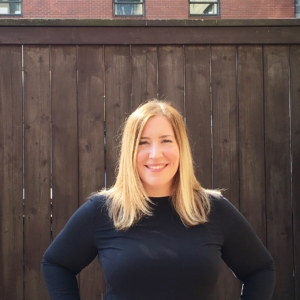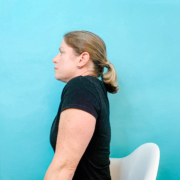The Aches and Pains of Your New Home Office
Our workdays look different now whether that means wearing a mask, socially distancing from our co-workers, or all together working from home. With these new safety protocols in place, it has never been more important to take a minute to stretch, to move and to listen to your body. For those still at home and feeling the aches and pains of contorting themselves into a pretzel on the couch, this is for you.
First, let’s talk ergonomics. We want to ensure that your at–home work station is optimized for comfort and productivity. The chairs at your office are ideal as they can go up and down, seat you in a position with both feet resting, and ensure your arms and shoulders are relaxed. If you are able to take home your beloved office chair, then do so, otherwise we suggest finding a work surface and seating that puts you in an optimal position.
The top of your computer screen should be at eye level so that you do not need to tilt your head. Our RMT Kielly recommends using cookbooks to stack under your computer to achieve this. Your keyboard should be close enough to ensure a 90 degree angle arm position. When using the computer mouse your arm movements should not be a ‘full movement,’ meaning that it should not come from your shoulder, but from your elbow. Keeping this in mind will help you to avoid developing shoulder pain from everyday tasks.
Next, we must move and stretch. Staying in any one position for too long while doing repetitive motions, typical of office work, can lead to aches and issues like ‘tech neck.’ Stretching throughout your day will help prevent fatigue, reduce stress on your body and should improve blood flow to your muscles. Kielly recommends setting at least two stretch breaks on your phone or calendar to make this a healthy habit.
At Spirit, we suggest stretching routines to our massage guests which typically focus on three areas: the neck, the shoulders, and the lower back. We’ve included a few simple ones that you can do at home. Stretching should feel like a nice, gentle pull. Make sure to breathe and to listen to your body. Drink water and stay hydrated. A little bit of stretching should be a nice break in your day and a little can go a long way. Always consult your physician before starting any new home care program.
Neck Roll
- Relax and tilt your head forward
- Slowly roll toward one side, leaning your ear towards the respective shoulder
- Repeat on other side
- Lift your chin back to the central starting position
- Do this three times for each direction
Chin Tuck
- Face straight ahead
- Tuck your chin inwards towards your neck
- Hold the stretch for 30 seconds (you will feel tension in the back of your neck)
- Relax and slowly return to the starting position
- Repeat 2 or 3 times
Shoulder Roll
- Sit at your desk with your chin slightly tucked.
- Keep your arms relaxed. All motion will be coming from your shoulders.
- Shrug your shoulders up toward your ears, then back. Circle your shoulders down and back.
- Repeat the circles at least 2 to 4 times.
Cat-Cow
- Begin in a tabletop position with the hands under the shoulders and the knees under the hips. Lengthen the crown of the head and the tailbone in opposite directions, parallel to the floor.
- The starting point is neutral with your back flat. On an exhale, begin to tuck the chin to the chest and curl the tailbone towards the floor so that the entire spine curves upward. (It should look like how a cat stretches after a nap.)
- Hold this pose for about 30 seconds
- Inhale. As you do, reverse the curve of the spine into a U-shape. Drop the belly and arch the back so that your eyes and tailbone point toward the sky.
- Hold this pose for about 30 seconds, remembering to breathe evenly.
Lower-Back Bridge Pose
- Lie on your back with your knees bent and feet on the floor. Extend your arms along the floor, palms flat and facing upwards.
- Press your feet and arms firmly into the floor. Exhale as you lift your hips toward the ceiling.
- Draw your tailbone upwards, holding your bottom off the floor. Do not squeeze your glutes.
- Optional: Roll your shoulders back and underneath your body. Clasp your hands and extend your arms along the floor beneath your pelvis. Straighten your arms as much as possible, pressing your forearms into the mat.
- Keep your thighs and feet parallel. Press your weight evenly across both feet and lengthen your tailbone towards the backs of your knees.
- Hold for up to one minute. To release, unclasp your hands and place them palms-up alongside your body. Exhale as you slowly roll your spine along the floor, vertebra by vertebra. Allow your knees to drop together.










